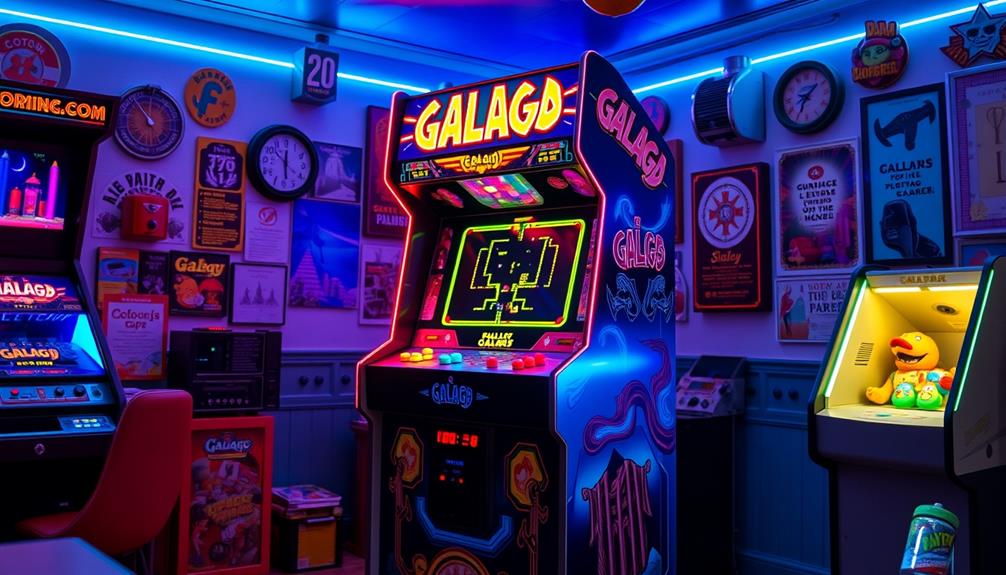During the golden era of the late 1970s to early 1980s, arcade games were incredibly popular. The craze started with the release of *Space Invaders* in 1978, captivating enthusiasts of arcade gaming. By 1982, there were approximately 24,000 arcade venues flourishing across the U.S., raking in a staggering $8 billion in revenue, surpassing revenue from pop music and Hollywood. Legendary games like *Pac-Man* and *Donkey Kong* became cultural sensations, captivating players and nurturing a sense of community. This period set the foundation for contemporary gaming as we know it today. Interested in learning more about the progression of arcade gaming and its influence? The addictiveness of the gameplay, user-friendly controls, and competitive spirit of arcade games were some factors why arcade games gained popularity. Moreover, the social aspect of gathering with friends or strangers to compete for high scores created a distinctive and thrilling environment that kept gamers coming back for more. The array of game genres, from traditional action games to innovative racing and puzzle games, also played a role in the enduring attraction of arcade gaming. Reflecting on it, the history of arcade gaming has significantly influenced how we engage with and appreciate video games today. The success of timeless titles like *Space Invaders* and *Pac-Man* paved the way for the emergence of home gaming consoles and the growth of e-sports. The evolution of arcade games not only mirrors advancements in technology, but also the evolving preferences and interests of gamers over time. The impact of the golden age of arcade gaming continues to reverberate in the gaming industry and remains a beloved aspect of pop culture history.
Key Takeaways
- The golden age of arcade games spanned from the late 1970s to the early 1980s.
- *Space Invaders* launched in 1978, igniting widespread fascination with arcade gaming.
- By 1982, the U.S. had about 24,000 video game arcades operating.
- Arcade revenue peaked at $8 billion in 1982, surpassing pop music and Hollywood.
- Iconic games like *Pac-Man* and *Donkey Kong* became cultural phenomena during this period.
Historical Context of Arcade Popularity
The golden age of arcade games marked a thrilling chapter in entertainment history, enchanting audiences from the late 1970s to the early 1980s. This era kicked off with *Space Invaders* in 1978, which ignited a fascination with arcade video games.
By 1982, the number of video game arcades in the U.S. peaked at 24,000, showcasing the arcade boom's impact on consumer culture. The arcade industry generated an astounding $8 billion in revenues, surpassing both pop music and Hollywood film combined, highlighting its financial success and cultural importance.
During this vibrant time, classic pinball machines also gained popularity, with enthusiasts drawn to their best rated pinball machines of 2024 and the excitement they offered. Iconic titles like *Pac-Man* contributed considerably to this growth, with over 400,000 cabinets sold.
The rapid innovation in game design meant that consumer preferences shifted quickly, leading to an average lifespan of arcade games lasting just four to six months. This fast-paced environment fueled competition among game developers, driving them to constantly create engaging experiences.
As you reflect on those vibrant arcade halls filled with the sounds of beeping and buzzing, it's clear that the golden age of arcade games remains a defining moment in gaming history, captivating players and shaping the future of entertainment.
The Golden Age of Arcades
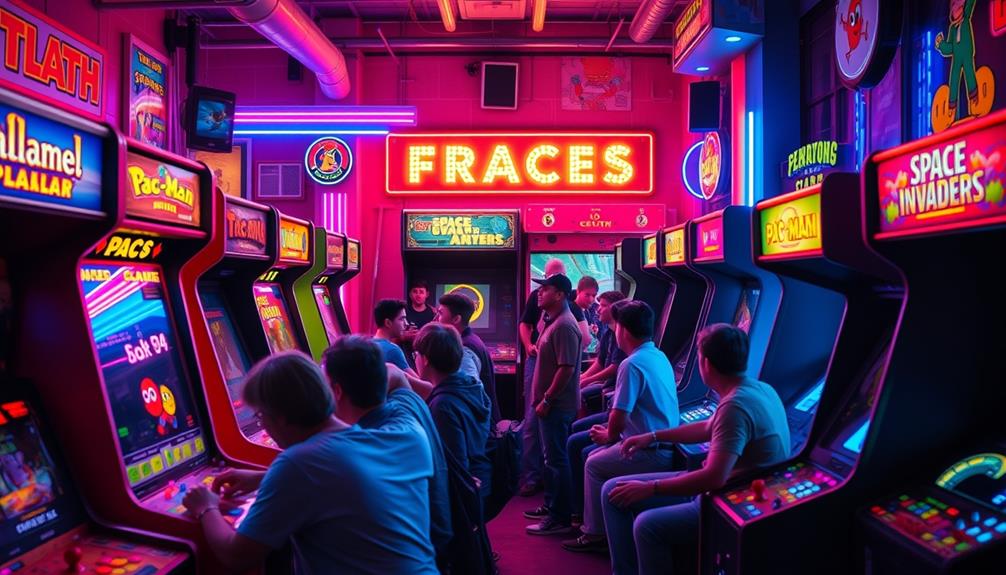
Arcades became a vibrant cultural phenomenon between 1978 and 1983, enchanting players and transforming social spaces. This period, known as the Golden Age of Arcades, marked a remarkable surge in popularity, driven by iconic titles and innovative gameplay that included the integration of modern technology in gaming experiences Best Arcade Machines for Home Game Rooms.
- The release of Space Invaders sparked an explosion in arcade machine sales, soaring from $50 million in 1978 to $900 million in 1981.
- By 1982, over 10,000 video game arcades were thriving in the U.S., generating a staggering $8 billion in revenue from quarters.
- Titles like Pac-Man and *Donkey Kong* became cultural icons, with *Pac-Man* alone selling around 400,000 cabinets and grossing over $1 billion.
During this golden age, the arcade industry not only flourished economically but also set the stage for modern esports, with video game tournaments gaining popularity.
The excitement of competing for high scores in these beloved games created a community that continues to resonate today. Players like you'd flock to these arcades, drawn in by the colorful lights and sounds, enthusiastic to experience the thrill of gaming's golden era.
Business Growth and Market Impact
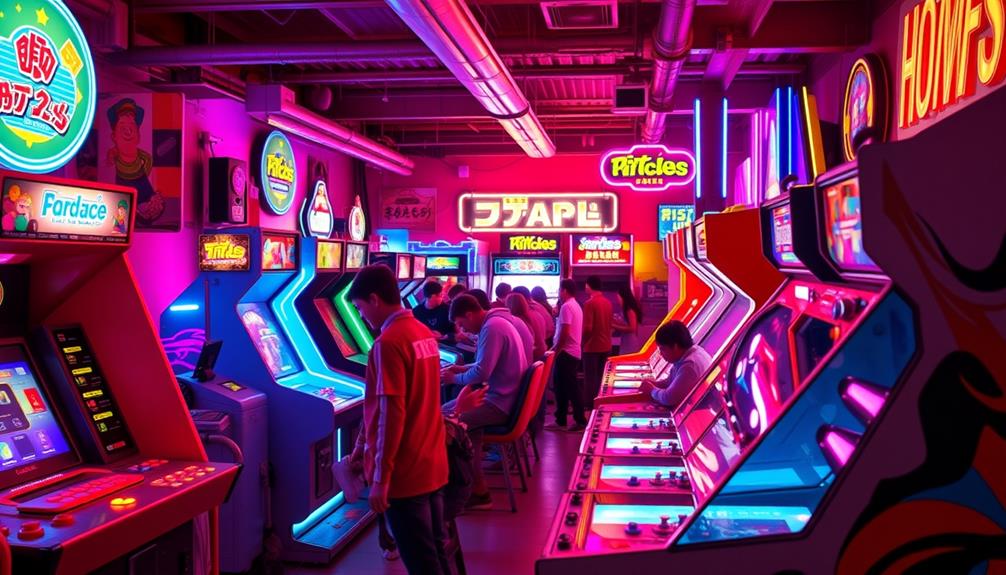
As video game arcades surged in popularity during the early 1980s, their impact on the entertainment industry became undeniable. The number of arcades in North America doubled from 1980 to 1982, reaching an impressive peak of 10,000. This growth was mirrored by arcade machine sales, which skyrocketed from $50 million in 1978 to $900 million by 1981, showcasing the booming market for video games.
This period also highlighted the relevance of budgeting for both operators and consumers, as many invested in gaming as both a leisure activity and a potential income source, emphasizing the importance of budget management.
By 1982, approximately 24,000 full arcades and 1.5 million active arcade machines were operating across North America. This expansion generated an astounding $8 billion in revenue from quarters alone, surpassing the combined revenues of pop music and Hollywood films.
Video games accounted for an impressive 87% of the total $8.9 billion in commercial game sales that year, solidifying their dominance in the entertainment industry.
The rapid growth of the arcade market not only transformed how people spent their leisure time but also influenced various sectors, leading to new business opportunities and innovations.
The arcade experience became a cultural phenomenon, shaping the landscape of entertainment for years to come.
Iconic Titles and Game Sales

Throughout the golden age of arcade gaming, iconic titles like *Space Invaders* and *Pac-Man* captivated players and drove the industry's growth. These games weren't just popular; they set records in game sales and revenue, shaping the arcade market's landscape. The cultural impact of these games can be compared to the enduring relationships seen in celebrity culture, such as Jennifer Aniston and Brad Pitt's connection.
- *Space Invaders* sold over 360,000 cabinets and grossed $2 billion by 1982, establishing itself as a cornerstone of arcade history.
- Released in 1980, Pac-Man became the best-selling video game of its time, with around 400,000 cabinets sold and over $1 billion generated by 1981.
- Other key titles like Ms. Pac-Man and *Asteroids* also made their mark, with sales of 115,000 and 70,000 units respectively.
These iconic titles showcased how arcade games could drive massive revenue and engage players. Significantly, games like *Defender* generated over $100 million, illustrating the financial impact of this era.
The fast-paced nature of the arcade scene meant games had an average lifespan of just four to six months, keeping the arcade market competitive and ever-evolving. This dynamic environment fueled both creativity and sales, making the golden age a remarkable chapter in gaming history.
Technological Innovations in Arcade Games
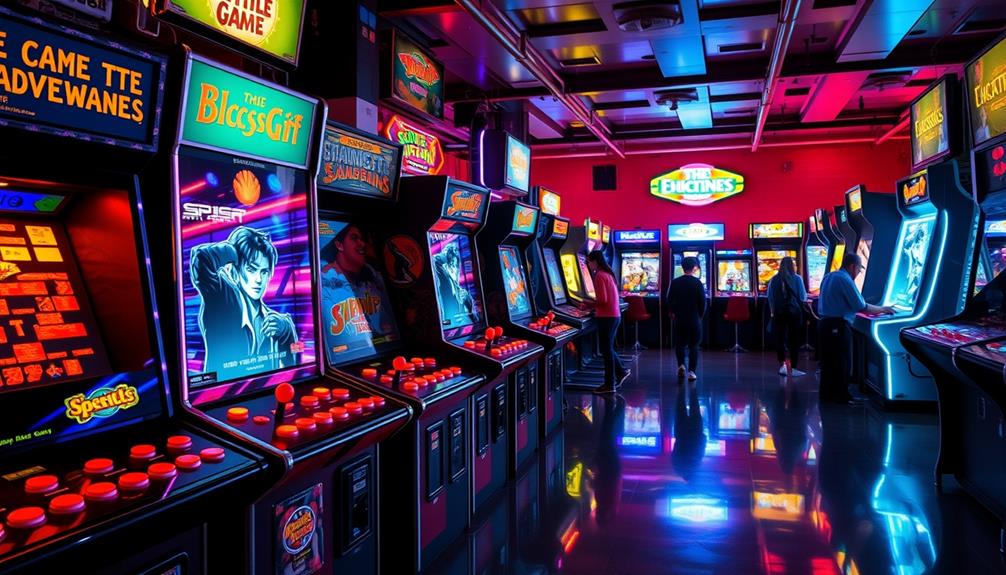
During the golden age of arcade games, groundbreaking technological innovations transformed the gaming experience. You witnessed the introduction of RGB color graphics and tile-based graphics in the late 1970s and early 1980s, which greatly enhanced the visual appeal of games.
Different zodiac signs, as discussed in astrology and attractiveness, might've influenced players' preferences for specific game aesthetics. Vector displays emerged, offering smoother and more dynamic graphics, seen in classics like *Asteroids* and *Battlezone*.
The arrival of digital audio allowed for immersive gaming experiences, making you feel more connected to the action. Iconic sound effects from games like *Pac-Man* became engrained in gaming culture, adding layers to your gameplay.
As skill-based gameplay mechanics developed, such as multiple lives in *Space Invaders*, you changed from mere reflex shooting to strategic planning and timing.
Hardware advancements led to a revolution in gameplay, evolving from 2D to real-time 3D graphics in the 1990s. Titles like *Street Fighter II* and *Dance Dance Revolution* showcased these innovations, creating rich and engaging environments.
Each technological leap not only made games more visually stunning but also enriched the overall gaming experience, propelling arcade games to new heights of popularity.
Cultural Influence of Arcades

The technological advancements in arcade games not only transformed gameplay but also had a profound cultural impact. During the golden age of arcades, iconic titles like *Pac-Man* and *Space Invaders* became cultural phenomena, shaping gaming culture in significant ways. You probably remember the thrill of seeing friends gather around arcade cabinets, competing for high scores, and sharing strategies.
The influence of these games can be seen in various aspects of entertainment, including music, as demonstrated by the popularity of songs inspired by gaming culture, such as Blue Skies and Lemonade, which captures feelings of joy and nostalgia.
- *Pac-Man* sparked "Pac-Mania," a frenzy that swept through the nation.
- The popularity of Space Invaders even led to a national shortage of 100 yen coins in Japan.
- The arcade industry's revenue peaked at $8 billion in 1982, surpassing pop music and Hollywood films combined.
These games weren't just entertainment; they influenced various industries. The music industry alone experienced a $400 million revenue drop attributed to the rise of arcade games.
Decline and Recovery of Arcades
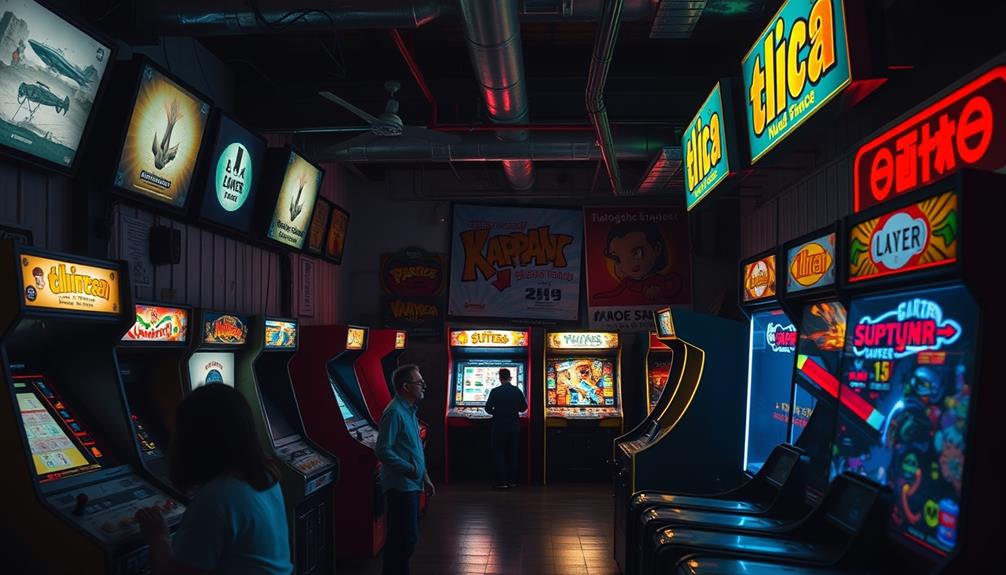
As arcade games surged in popularity during the late 1970s and early 1980s, a sharp decline followed just a few years later, driven by market saturation and changing consumer preferences.
The arcade industry faced a dramatic drop in revenue, plummeting from $8.9 billion in 1982 to $4.5 billion by 1984. This decline prompted the mid-1980s recovery efforts, which included the introduction of software conversion kits that allowed operators to refresh their games without costly hardware changes.
The evolving landscape also saw parallels in other industries, such as the use of essential oils for various health benefits, highlighting how businesses adapt to consumer needs. New genres like beat 'em ups emerged, revitalizing interest and leading to a resurgence in arcade popularity.
By 1986, arcade revenue began climbing again, reaching $5.5 billion by 1988, equivalent to about $14.2 billion today. The rise of fighting games also fueled predictions of another arcade boom by the early 1990s.
In response to changing consumer demands, the 1990s saw arcades transform into Family Entertainment Centers, offering diverse attractions that kept them relevant in the evolving gaming landscape.
This adaptation allowed the industry to weather the storm and find new life amid a challenging environment.
The Future of Arcade Gaming
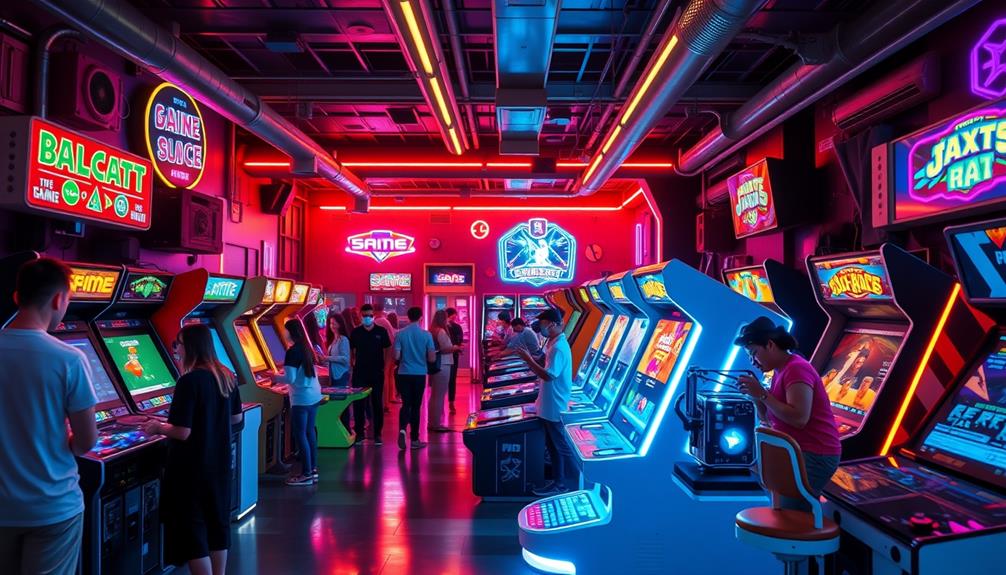
As you look ahead, the future of arcade gaming seems to blend nostalgia with exciting technological innovations.
With advancements in AI-powered virtual reality in e-learning, arcade games could offer immersive experiences that engage players like never before.
You'll find retro games making a comeback in trendy barcades, while new titles push the limits of graphics and gameplay.
This fusion could redefine your gaming experience, inviting you to enjoy both the classics and cutting-edge advancements in interactive entertainment.
Nostalgia and Retro Appeal
Nostalgia for classic arcade experiences is driving a resurgence in retro gaming, capturing the hearts of both older generations and newcomers. You might find yourself drawn to the thrill of iconic titles like Pac-Man and Donkey Kong, which continue to resonate with audiences today.
The emergence of adult-oriented arcades, often called "barcades," enhances social experiences, making it easy to enjoy a drink while reliving those cherished memories. This revival mirrors trends seen in other areas of entertainment, such as Paula Deen's Wedding Highlights, where a blend of tradition and contemporary flair creates memorable experiences.
Here are a few reasons why retro games are making a comeback:
- Social Experience: Barcades provide a lively atmosphere, merging nostalgia with modern social gatherings.
- Iconic Titles: Games like Mortal Kombat remind players of the golden age of arcades, fostering a sense of connection to gaming history.
- Adaptation to Trends: Many arcades blend classic gameplay with e-sports and modern technology, ensuring a diverse gaming culture.
With this revival, the essence of classic arcade gaming is preserved while integrating fresh elements.
Whether you're revisiting old favorites or discovering them for the first time, the appeal of retro games is undeniable, making arcade gaming a vibrant part of today's entertainment landscape.
Technological Innovations and Trends
The revival of arcade gaming isn't just fueled by nostalgia; it's also driven by exciting technological innovations that shape its future. The shift from 2D to real-time 3D polygon graphics in the 1990s, led by systems like Sega Model 1, marked a significant technological advancement. Innovations such as texture mapping and shading, popularized by Namco's System 22 and Sega Model 2, have enhanced visual fidelity, making arcade games even more immersive.
In this evolving landscape, mastering SEO techniques can be essential for developers aiming to reach wider audiences with their games. Today, competitive gaming events, especially in the fighting game genre, have reignited interest in arcade-style play, creating vibrant communities centered around these experiences.
While traditional arcade formats faced decline due to the rise of home consoles, contemporary titles now leverage modern technology to incorporate classic gameplay elements.
You'll also notice a trend toward nostalgia-driven arcades, often called "barcades," merging social experiences with gaming, catering to those who fondly remember the arcade days. This blend of old and new guarantees that arcade gaming continues to evolve, appealing to both seasoned players and newcomers alike.
As technology advances, the future of arcade gaming looks bright, promising innovations that honor its rich history while inviting you to experience the thrill anew. With the integration of virtual reality and augmented reality, the boundaries of interactivity and immersion are being redefined, making arcade gaming more captivating than ever. Developers are also reimagining the most popular arcade games of the past, blending nostalgic gameplay with cutting-edge graphics and mechanics to engage both veteran players and newcomers alike. This seamless fusion of tradition and innovation ensures that arcades will continue to thrive as dynamic social and entertainment hubs for years to come.
Frequently Asked Questions
When Did Arcades Peak in Popularity?
Arcades peaked in popularity during the early 1980s, with iconic games enchanting you. You'd find yourself immersed in vibrant spaces, surrounded by buzzing machines, as the industry exploded, drawing millions into this thrilling entertainment domain.
When Did Arcade Games Lose Popularity?
Arcade games lost popularity primarily in the late 1980s as home consoles gained traction. You'll notice this shift as players began favoring immersive, narrative-driven experiences over the simpler, short-lived excitement of arcade machines.
Were Arcades Popular in the 2000S?
You might say arcades took a backseat in the 2000s. As home consoles and mobile gaming flourished, many players preferred immersive experiences at home, leaving traditional arcades to reinvent themselves to stay relevant.
Were Arcades Popular in the 80S?
Arcades thrived in the 80s, drawing millions of gamers with iconic titles like *Pac-Man* and *Space Invaders*. You'd find vibrant scenes filled with excitement, competition, and camaraderie, making it a golden era for gaming.
Conclusion
As you step back from the vibrant glow of arcade screens and the symphony of bleeps and bloops, you can see how these gaming havens have evolved. From the bustling arcades of the 80s to the quiet resurgence of today, their legacy remains. Each joystick and button tells a story, weaving nostalgia into the fabric of modern gaming. While the landscape has changed, the spirit of competition and camaraderie continues to thrive, promising a bright future for arcade enthusiasts everywhere.

